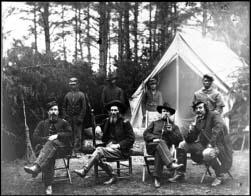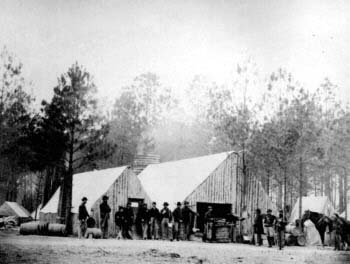
June 9, 1863
The Battle of Brandy Station was the largest cavalry battle ever fought on
the North American Continent. Of the 20,000 soldiers involved, about 17,000 were
of the mounted branch. Brandy Station is also the first battle of the war's most
famous campaign-- Gettysburg.
The Confederates had planned for June 9, 1863 to be a day of maneuver rather
than of battle. Two of the army's three infantry corps were near Culpeper, six
miles southwest of Brandy Station, poised to move onto the Shenandoah Valley and
thence up to Pennsylvania. Major General J.E.B. Stuart, at Brandy Station, was
to screen this movement with his 9,500-man cavalry division, while the remaining
infantry corps held the attention of the Union Army at Fredericksburg, 35 miles
southeast of Brandy Station.
 The Federals know
that Confederate cavalry was around Culpeper, but its intelligence had not
gathered information of the sizeable infantry force behind the horsemen. Army
of the Potomac commander, Major General Joseph Hooker, interpreted the enemy
cavalry's presence around Culpeper to be indicative of preparations for a raid
on his army's supply lines. Accordingly, he ordered his Cavalry Corps commander,
Brigadier General Alfred Pleasonton to "break up Stuart's raid in its
incipiency." The Federals know
that Confederate cavalry was around Culpeper, but its intelligence had not
gathered information of the sizeable infantry force behind the horsemen. Army
of the Potomac commander, Major General Joseph Hooker, interpreted the enemy
cavalry's presence around Culpeper to be indicative of preparations for a raid
on his army's supply lines. Accordingly, he ordered his Cavalry Corps commander,
Brigadier General Alfred Pleasonton to "break up Stuart's raid in its
incipiency."
The Confederates apparently did not expect any harassment from the enemy
cavalry, for the day before the important screening mission was scheduled to
take place, the Southern troops conducted a grand review for General Robert E.
Lee at Inlet Station, just two miles southwest of Brandy Station. Meanwhile,
8,000 Federal cavalrymen, organized into three divisions, and about 3,000
Northern infantrymen were preparing to disrupt the Confederate plans.
About 4:30 a.m. on June 9th, Brigadier General John Buford's column of 5,500
soldiers splashed across the fog-shrouded Rappahannock River surprising the
Confederate pickets at Beverly's Ford. Nearby Southern horsemen from Brigadier
General William "Grumble" Jones' brigade, awakened by the sound of gunfire, rode
into the fray partially dressed and often riding bareback. They struck Buford's
leading brigade, commanded by Colonel Benjamin F. "Grimes" Davis, near a bend in
the Beverly's Ford Road and temporarily checked its progress. In the fighting
Davis was killed.
Davis' brigade had been stopped just short of where the Confederate Horse
Artillery was camped and was vulnerable to capture. Cannoneers swung one or two
guns into position and fired down the road at Buford's men, enabling the other
pieces to escape and establish the foundation for the subsequent Confederate
line. The artillery unlimbered at the Gee House and at St. James
Church--structures located on two knolls on either side of the Beverly’s Ford
Road. Most of Jones’ command rallied to the left of this Confederate artillery
line, while Brigadier General Wade Hampton’s brigade formed to the right. The
6th Pennsylvania Cavalry suffered the greatest casualties of any regiment
participating in the battle when it unsuccessfully charged across a field to the
very muzzles of the guns at St. James Church.
Realizing that the Southern artillery blocking the direct route to Brandy
Station was a force too strong to be dislodged, Buford determined to anchor his
right on the Hazel River and try to turn the Confederate left. But he found
Brigadier General W.H.F. "Rooney" Lee's brigade blocking his advance with some
troops on a piece of high ground called Yew Ridge and some dismounted troopers
positioned along a stone wall in the front. After sustaining heavy losses, the
Federals wrestled the stone wall away from the Confederates. Then, to the
amazement of Buford's men, the Confederates began pulling back.
The Southerners were shifting to meet a new threat, adjusting to their second
surprise of the day. Brigadier General David M. Gregg's Union division of about
2,800 men had orders to cross the Rappahannock at Kelly's Ford and proceed on
roads leading directly into Brandy Station, but discovered its way blocked by
Brigadier General Beverly Robertson's Brigade. however, Gregg determined that
another road network leading to the battlefield by a more circuitous route was
completely unguarded. Following these roads, his lead brigade under Colonel
Percy Wyndham arrived in Brandy Station about 11 a.m. Between Gregg and the
battle taking place between Buford and Stuart was a prominent ridge called
Fleetwood Hill. The eminence had been Stuart's headquarters, but the general was
at the front and the only force on Fleetwood when Gregg arrived was a 6-pounder
howitzer, which had been sent to the rear for want of reliable ammunition. Major
Henry B. McClellan of Stuart's staff pressed this gun into service and sent a
desperate plea to his chief for reinforcements. Wyndham meanwhile formed his men
into line and charged up the western slope of Fleetwood. As he neared the crest,
the lead elements of Jones's brigade, which had just withdrawn from St. James
Church, rode over the crown.
Gregg's next brigade, led by Colonel Judson Kilpatrick, swung around east of
Brandy Station and attacked up the southern end and the eastern slope of
Fleetwood Hill, only to discover that their appearance coincided with the
arrival of Hampton's Confederates. A series of confusing charges and
countercharges swept back and forth across the hill. The Confederates cleared
the hill for the final time, capturing three guns and inflicting 30 casualties
among the 36 men of the 6th New York Light Artillery, which had attempted to
give close-range support to the Federal cavalry.
Colonel Alfred Duffié, with a small 1,200-man division, was delayed by two
Confederate regiments in the vicinity of Setvensburg and arrived on the field
too late to participate in the action.
While Jones and Hampton withdrew from their initial positions to fight at
Fleetwood Hill, "Rooney" Lee continued to confront Buford, falling back to the
northern end of the hill. Reinforced by Colonel Thomas Munford, commanding the
brigade of the ailing Fitzhugh Lee, "Rooney" Lee launched a counterattack
against Buford at the same time as Pleasonton had called for a general
withdrawal, and the battle was over.
Despite being surprised by his adversary twice in the same day, Stuart was
able to retain the field. Union losses numbered 866; Confederate casualties were
reported at 575. But the overwhelming superiority that the Confederate cavalry
once enjoyed was gone.
Copyright © 1996
Last modified:
February 23, 2009
|